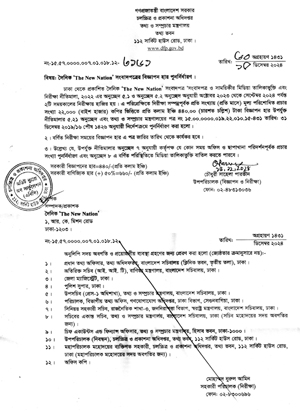Dr. Tanvir Abir :
The rise of Artificial Intelligence (AI) has reshaped global economies, industries, and societies. Countries that strategically invest in AI are not only enhancing their technological capabilities but also unlocking unprecedented economic opportunities. For Bangladesh, AI holds the potential to emerge as a significant export sector, even surpassing the dominant garment industry in the long term. However, achieving this transformation requires a comprehensive strategy and a concerted effort from multiple stakeholders.
To realize this vision, Bangladesh must prioritize AI education and skill development at all levels, spanning primary schools, universities, and vocational training centers. The government should foster a conducive environment for AI startups and research institutions by offering tax incentives, grants, and infrastructure support. Furthermore, fostering partnerships between local tech companies and global AI leaders can accelerate knowledge transfer and position Bangladesh as a hub for AI innovation in South Asia.
Global Perspective on AI as an Export Sector
Globally, AI has emerged as a transformative force driving innovation and economic growth. The global AI market, valued at approximately USD 136 billion in 2022, is projected to grow at a compound annual growth rate (CAGR) of 37.3 per cent from 2023 to 2030. AI applications are revolutionizing industries such as healthcare, finance, manufacturing, and logistics, offering solutions that enhance efficiency and reduce costs.
Countries like the United States, China, and India are leading AI development. The US boasts Silicon Valley, a global hub for tech innovation, while China is rapidly scaling AI applications across industries, investing heavily in research and development (R&D). India, leveraging its vast pool of skilled professionals, has positioned itself as a global leader in IT services and is now capturing a significant share of the AI market. These nations’ success underscores the importance of infrastructure, skilled human resources, and government support in fostering AI as a major export sector.
Bangladesh, as an emerging economy, has the opportunity to carve out a niche in this booming market. However, a comparative analysis reveals that while global giants are leveraging advanced ecosystems, Bangladesh remains in the nascent stages of AI development. Bridging this gap is imperative to compete on a global scale.
Bangladesh Perspective: Current Landscape and Challenges
Bangladesh’s economy heavily relies on its garment sector, which accounts for over 80 per cent of export earnings. While the garment industry has been a cornerstone of economic growth, it remains labor-intensive and vulnerable to global disruptions such as changes in trade policies, automation, and shifting consumer demands. Diversifying the export basket is not only desirable but also essential for sustainable growth. AI presents a promising alternative.
However, Bangladesh faces several challenges in establishing AI as a major export sector: AI development requires a highly skilled workforce proficient in data science, machine learning, and software engineering. The country’s education system has yet to produce the volume of experts needed to compete globally.
High-speed internet, advanced computing facilities, and reliable energy supply are critical for AI development. Bangladesh needs significant investment to upgrade its technological infrastructure. Unlike nations investing heavily in AI research, Bangladesh’s spending on innovation and technology is minimal, limiting the development of locally relevant AI solutions and exportable products. The absence of comprehensive policies to support AI startups and attract foreign investment hinders the sector’s growth.
Opportunities for AI in Bangladesh
Despite these challenges, Bangladesh holds immense potential to emerge as a competitive player in the AI domain. With the right strategies, the country can capitalize on its growing tech-savvy youth population, increasing interest in IT services, and cost-competitive labor force. Key opportunities include:
Investments in education and training programs focusing on AI, data analytics, and machine learning can create a skilled workforce. Partnerships with international universities and organizations can accelerate this process.
AI can enhance the efficiency of existing sectors, including garments, agriculture, and healthcare. For example, AI-driven automation in the garment industry can optimize production and reduce waste, ensuring competitiveness in the global market.
Introducing favorable policies, tax incentives, and funding opportunities for AI startups can create an enabling environment for innovation. Additionally, setting up AI innovation hubs and incubation centers can nurture new ideas.
Bangladesh can focus on developing AI solutions tailored for specific global markets, such as low-cost automation tools for small and medium enterprises (SMEs) or AI-driven logistics solutions for developing economies. Forming alliances with leading AI firms can provide access to advanced technologies, funding, and global markets.
A Collaborative Approach for Success
For AI to become a major export sector, Bangladesh must adopt a multi-stakeholder approach involving the government, private sector, academia, and international partners. The following steps are critical:
The government should create a robust policy framework to support AI innovation, attract foreign direct investment (FDI), and protect intellectual property rights (IPR). Collaboration between the government and private sector can drive infrastructure development, funding for startups, and implementation of AI projects.
Introducing AI-focused curricula in universities and technical institutes will ensure a steady pipeline of skilled professionals. Promoting Bangladesh as a destination for affordable and high-quality AI solutions can attract international clients and investors. Offering grants, low-interest loans, and tax exemptions for AI startups can encourage entrepreneurship and innovation.
Synergy between AI and Garment Industry
Rather than viewing AI as a competitor to the garment industry, Bangladesh can explore synergies between the two sectors. AI-driven solutions can enhance productivity, streamline supply chains, and improve quality control in garment manufacturing. Predictive analytics, for instance, can optimize production schedules, while computer vision technology can identify defects during quality checks. This integration ensures that both sectors contribute to the country’s economic growth.
While prioritizing AI education and skill development, Bangladesh must also address challenges such as the digital divide, ethical concerns, and job displacement that may arise from rapid AI adoption. A proactive, inclusive approach will ensure that the country reaps the full benefits of this transformative technology.
(The writer is Associate Professor, Department of Business Administration, Daffodil International University).



